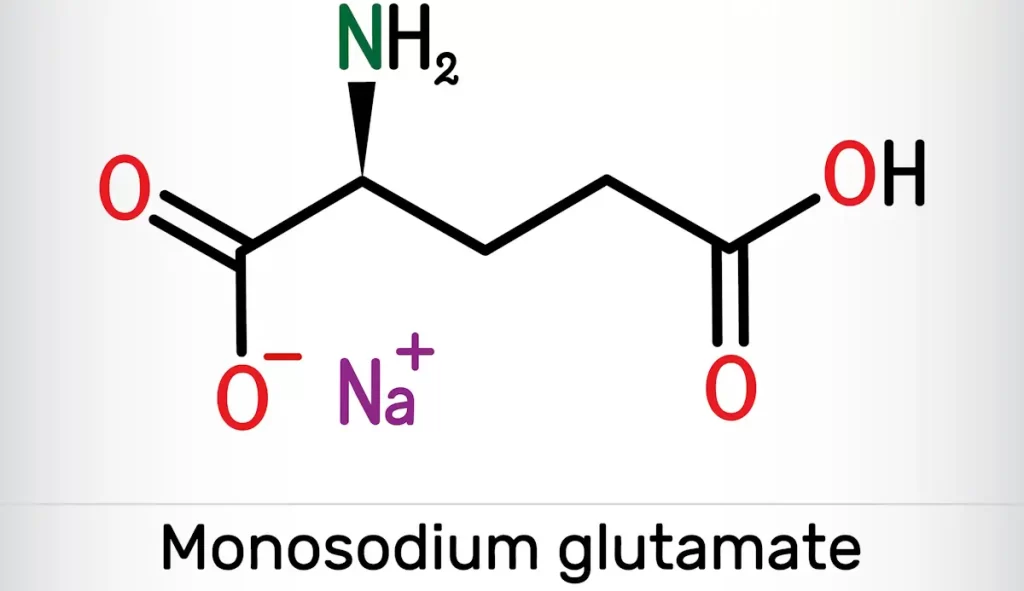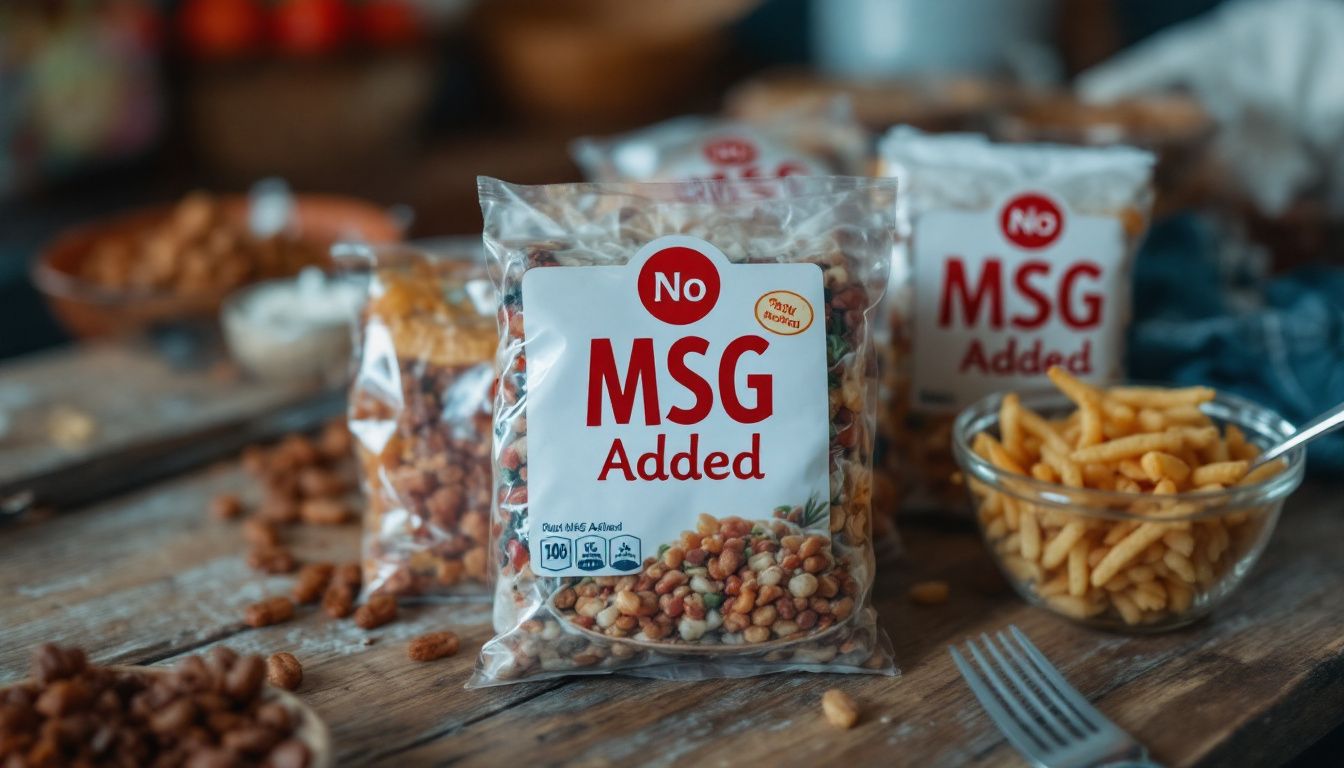Do you ever wonder if MSG in your food is safe? Monosodium glutamate, a common flavor enhancer, is found in many processed foods and restaurant meals. This blog will explain what MSG is, why it’s used, and the health concerns tied to it.
Thank you for reading this post, don't forget to subscribe!Keep reading to learn more!
Key Takeaways
- MSG is a flavor enhancer made by fermenting starch or sugars. It boosts the savory umami taste and is widely used in fast food, snacks, and processed items like sauces and meats.
- Less than 1% of people are sensitive to MSG. Symptoms like headaches, flushing, or nausea occur within two hours of eating high-MSG foods. Large doses (over 3 grams) without food may cause these effects.
- Studies suggest typical daily intake (0.3-1 gram) is safe for most people. Research also shows MSG can lower sodium levels when used as a substitute for table salt while maintaining flavor.
- Ultra-processed foods with additives like MSG link to health risks such as type 2 diabetes and heart disease, per a 2024 BMJ review. They make up 67% of kids’ calorie intake in the U.S., raising long-term concerns.
- To avoid MSG, check labels for terms like “monosodium glutamate” or hidden names such as “natural flavors.” Cooking fresh meals at home ensures control over ingredients while skipping added chemicals entirely.
What Is MSG and Why Is It Used?
MSG, or monosodium glutamate, is a food additive. It combines sodium and L-glutamic acid, a nonessential amino acid found naturally in foods like tomatoes and cheese. Kikunae Ikeda, a Japanese chemist, created the first synthetic MSG in 1908 after studying seaweed broth.
Today’s version is made by fermenting starch, sugar cane, sugar beets, or molasses into white crystals.
It enhances flavors by boosting the umami taste—a savory profile distinct from salty or sweet. This makes it popular in processed foods like soups, sauces, potato chips, and salad dressings.
The U.S. FDA considers MSG “generally recognized as safe” (GRAS), with an acceptable daily intake of 14 mg per pound of body weight. Its ability to make meals tastier explains its widespread use in snacks and packaged foods across fast-food chains and supermarkets alike.
Common Foods That Contain MSG
MSG is a common flavor enhancer found in many foods. It’s used to add a savory taste and improve flavor in various dishes.
- Fast Food: Many chains, including McDonald’s, KFC, and Chick-Fil-A, use MSG in items like chicken nuggets and fried chicken.
- Packaged Foods: Instant noodles, chips, frozen meals, sauces, and seasonings often contain added MSG for better taste.
- Processed Meats: Hot dogs, sausages, bacon, and lunch meats may include MSG to enhance their flavor profile.
- Condiments: Popular products like ketchup, mayonnaise, salad dressings, and mustard sometimes have MSG or yeast extract as an ingredient.
- Low-Sodium Products: Soups and prepackaged meals labeled as “low-sodium” often rely on MSG for seasoning instead of extra salt.
- Dairy-Based Items: Processed cheese spreads or dips can list hydrolyzed vegetable protein or autolyzed yeast containing glutamates.
- Convenience Foods: Snacks like flavored fries or salty crackers frequently use MSG to boost appeal.
- Chinese Food: Some Chinese restaurant dishes still include MSG despite growing awareness about sensitivity.

Potential Health Concerns Linked to MSG
MSG has been linked to health issues like headaches and flushing in some people—read on to learn more about these concerns.
Headaches and flushing
Headaches and skin flushing may occur after consuming high doses of monosodium glutamate (MSG). These symptoms, sometimes called “MSG symptom complex” or “Chinese restaurant syndrome,” often appear within two hours.
They might include sweating, nausea, rapid heartbeat, numbness, or weakness.
Most reactions happen when people consume over 3 grams of MSG without food. Such amounts are uncommon in a standard diet but can still cause discomfort for those sensitive to MSG. Less than 1% of the population experiences these effects regularly.
Neurological effects
MSG may overstimulate nerve cells in the brain. Some studies on animals show high doses can lead to neuronal damage and changes in brain structure, especially during early development.
For example, research by Moneim WMA (2018) found cognitive issues in male albino rats exposed to MSG.
Excessive glutamate levels could harm brain chemistry by over-activating glutamate receptors. This process might cause oxidative stress and inflammation. In rare cases, sensitive individuals report mild symptoms like headaches or confusion after eating foods with MSG.
Scientists are still exploring how dietary MSG affects signals involved in thinking and memory.
Who Might Be Sensitive to MSG?
Less than 1% of people may react negatively to monosodium glutamate (MSG). This reaction, known as MSG sensitivity or “MSG symptom complex,” can cause symptoms like headaches, skin flushing, sweating, nausea, numbness, fatigue, and chest pain.
Some also experience rapid heartbeat or weakness. These effects usually appear within two hours after eating foods high in MSG.
Avoiding foods with this flavor enhancer is the best way for sensitive individuals to prevent these issues. Processed meats like salami and seasoning blends often contain MSG. Packaged foods and meals made with hydrolyzed yeast or free glutamate are other common sources.
If symptoms occur regularly after consuming such items, it might signal sensitivity to this food additive.
MSG’s Role in Sodium Intake
MSG has about one-third the sodium of table salt. It contains 12.28 grams of sodium per 100 grams, while table salt packs 39.34 grams per 100 grams. Using MSG instead of some salt can cut down your sodium intake without losing flavor.
Replacing half a teaspoon of table salt with the same amount of MSG reduces sodium by around 37%. Foods like soups, processed meats, and dairy often use MSG as a low-sodium substitute to maintain taste.

Why Consider Reducing MSG in Your Diet?
Reducing MSG in your diet may help avoid mild symptoms like headaches, flushing, or nausea. This reaction is sometimes called the “MSG symptom complex.” These symptoms often appear within two hours of eating foods with MSG.
People sensitive to this food additive might find relief by cutting back on it.
MSG is common in processed foods, seasoning blends, and packaged snacks. Eating less of these can also lower calorie intake and reduce sodium levels—important for better heart health.
Learning to spot MSG in ingredient lists leads to smarter food choices.
Continue reading for tips on finding and avoiding foods containing MSG…
Tips for Identifying and Avoiding MSG in Foods
MSG is common in many foods, especially processed ones. Learn how to spot and avoid it with these tips.
- Check food labels – Look for “monosodium glutamate,” yeast extract, or hydrolyzed proteins in the ingredient list. These are forms of MSG.
- Watch for hidden names – MSG can show up as “natural flavors” or “seasonings.” Be extra careful with packaged foods.
- Be cautious at restaurants – Many fast-food chains and Asian restaurants use it as a flavor enhancer. Ask if their dishes contain MSG when dining out.
- Look for ‘No MSG’ claims – Some products clearly state they contain no added MSG. This makes them easier to identify and choose at the store.
- Avoid ultra-processed foods – Items like chips, frozen dinners, and seasoning blends often include MSG as a food additive to boost flavor.
- Pay attention to condiments – Soy sauce, salad dressings, and soup bases commonly contain this additive too—read those labels closely before buying.
- Cook fresh meals at home – Preparing your own meals helps you control ingredients, skipping unnecessary additives like MSG entirely.
- Choose whole foods over processed options – Foods like fruits, vegetables, meat, and grains naturally have no added MSG or artificial flavors.

Current Research on MSG’s Health Effects
Studies question MSG’s health risks. A 2016 review by Obayashi Y found weak support for links between MSG and headaches. Some symptoms, like flushing or nausea, appear at much higher doses than typical in food.
Most people consume only 0.3-1 grams daily in Europe—far less than levels causing harm in animal tests.
Certain findings suggest benefits too. Research by Wallace TC (2019) shows MSG works as a salt substitute, helping lower sodium intake in savory foods without losing flavor. Another study by Miyaki T (2016) reported that soups with MSG reduced calorie intake among overweight women later on—possibly aiding weight control efforts over time.
More studies are still needed to explore long-term effects.
Ultra-Processed Foods and Health: New Evidence on Their Risks
Ultra-processed foods (UPFs) contain long lists of ingredients. They often have chemical additives and very little whole food content. A 2024 BMJ review found a link between eating these foods and 32 health conditions, including type 2 diabetes and heart disease.
Diets high in UPFs can cause inflammation, which leads to chronic health problems. These foods make up 67% of calories eaten by kids and teens in the U.S., raising concerns about public health.
Eating more UPFs increases the risk of death, as shown by many studies. People who follow an ultra-processed diet gained two pounds in just two weeks, while those on fresh diets lost weight instead.
Common examples include packaged foods like chips or processed meats filled with flavor enhancers like monosodium glutamate (MSG). Cutting back on these may help lower risks tied to sodium intake, inflammatory diseases, and poor metabolic function over time.
Conclusion
MSG is a big topic in food and health discussions. While MSG can boost flavor, it sits in many processed foods that may not be great for you. Some people feel fine eating it; others might have mild issues like headaches or flushing.
Knowing what’s in your food empowers smarter choices. Balance and awareness are key to a healthier diet!
